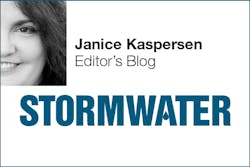
A few weeks ago in this space, I mentioned the algae blooms plaguing Florida this year, largely the result of nutrient-rich water being released from Lake Okeechobee. Unfortunately, it’s not just Florida that’s experiencing the problem—there’s plenty to go around.
A recently published study in Science shows that excess nutrients from agricultural runoff are likely to cause more problems in waters throughout the US in the coming years. This is not only because of the amount of fertilizer we apply to crops, but also because of changing rainfall patterns.
The authors of the study say that warmer temperatures will cause heavier rainfall—not simply more precipitation overall, but more of it at once—leading to increased runoff and greater loss of nutrients from soils. “Offsetting this increase would require a 33 ± 24% reduction in nitrogen inputs, representing a massive management challenge,” they report.
The nutrients make their way into rivers and eventually to the oceans, causing eutrophication and dead zones. The dead zone in the Gulf of Mexico is the largest yet recorded—as this article reports, it currently measures 8,776 square miles, or about the size of New Jersey. (A few years ago the Gulf’s dead zone was compared to the size of Connecticut, then to Connecticut and Rhode Island together. This year, researchers at Louisiana State University have predicted it might increase to as much as 10,000 square miles, or about the size of Vermont. This hardly seems fair to the New England states. Let’s hope we can limit the damage before we need to start invoking Texas for comparison.) The dead zone in the Chesapeake Bay is also larger this year than average.
Similarly changing rainfall patterns are expected in China, India, and throughout Southeast Asia. “It is therefore imperative that water quality management strategies account for the impact of projected future changes in precipitation on nitrogen loading,” the study warns.
An update: On the Water Efficiency site this week, editor Laura Sanchez describes a promising technology from Sandia National Laboratories that removes algae from the water and converts it to energy. Experiments in California’s Salton Sea have gone well, and the system may soon be ready for testing elsewhere.
We’re Still Seeking Moderators for StormCon Sessions
For those of you planning on attending the StormCon conference in Bellevue, WA, in August, we’re still looking for moderators for several of the conference sessions. You can find the complete program and other details of the conference at www.StormCon.com. If you’re interested in being a moderator, please contact me ([email protected]) or Brigette Burich ([email protected]) for details.
About the Author
Janice Kaspersen
Janice Kaspersen is the former editor of Erosion Control and Stormwater magazines.